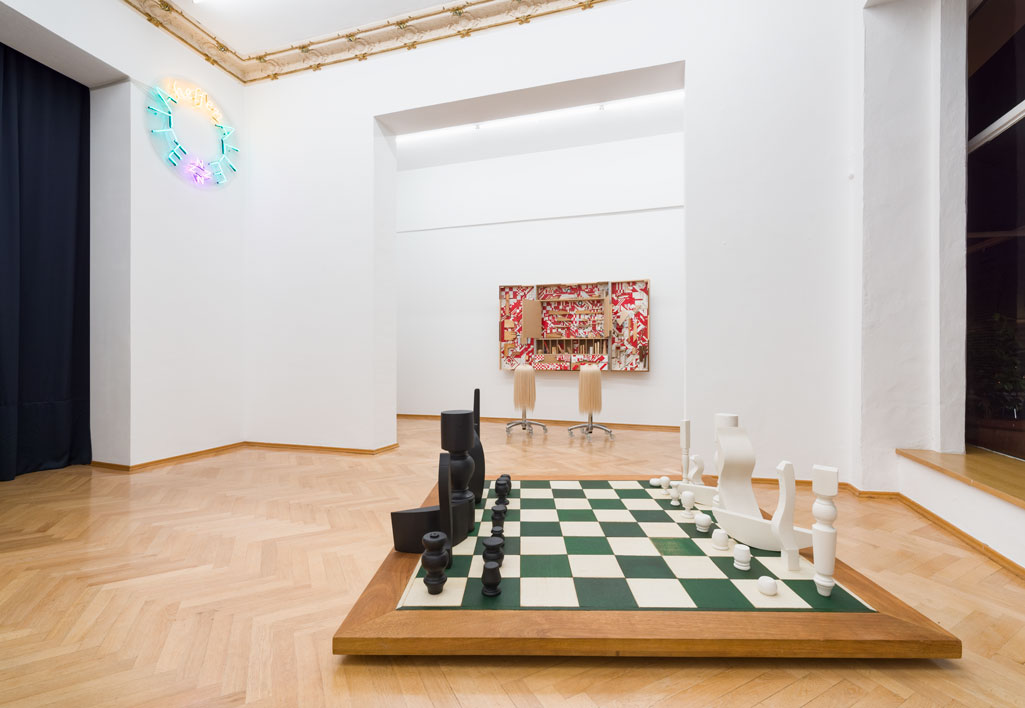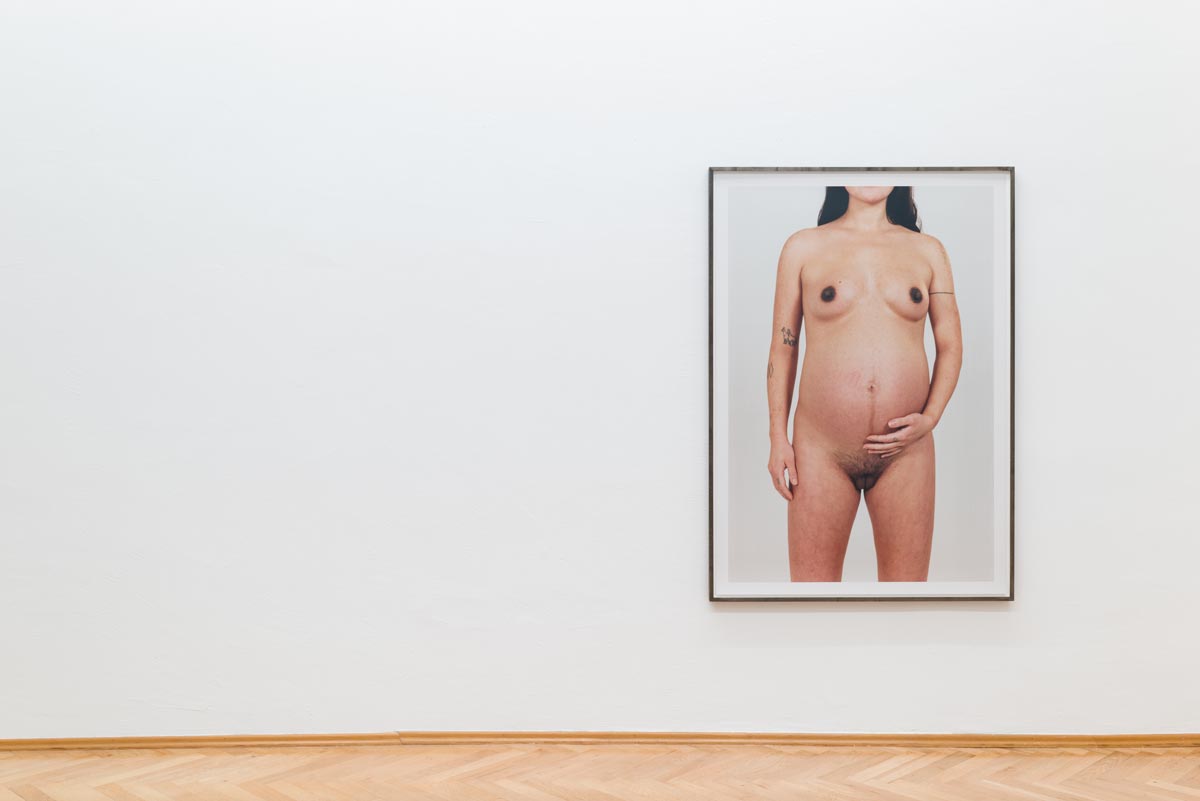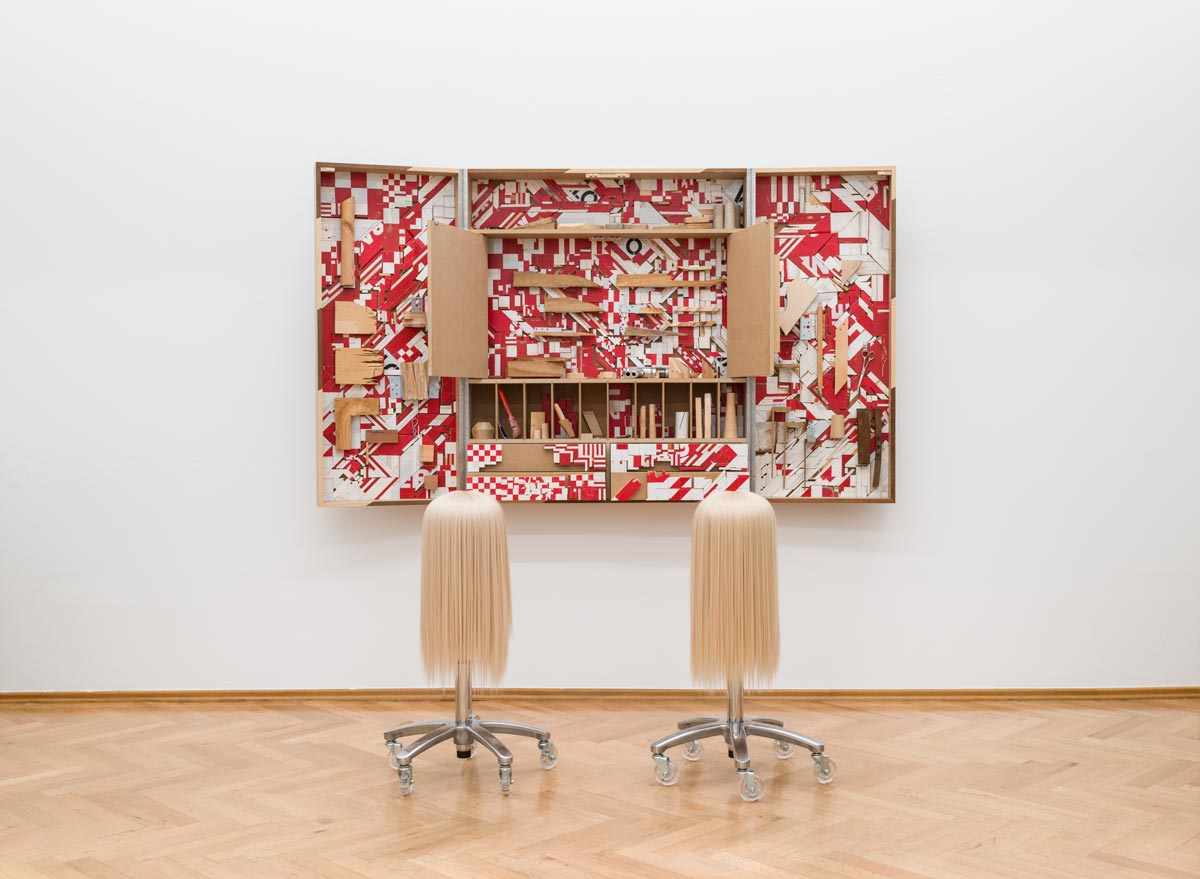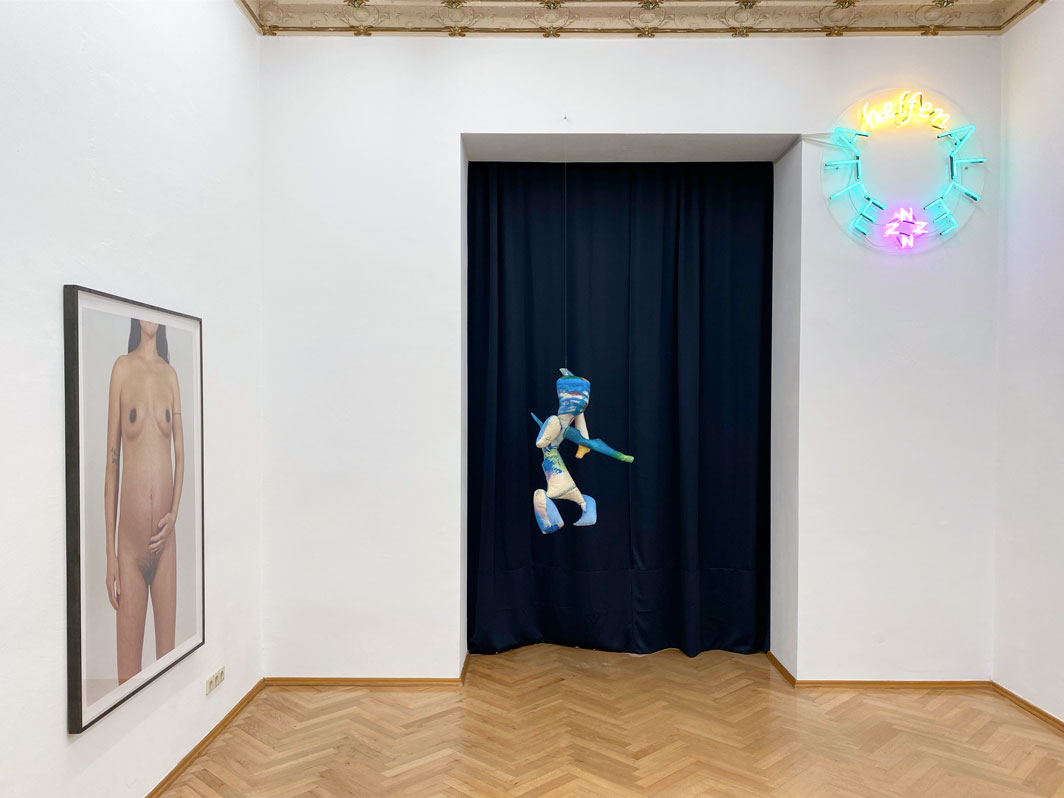



(english version below)
Interactions 6
konfrontiert Objekte von Hannah Parr mit einer Fotografie von Isabelle Graeff. Beide Künstlerinnen beschäftigen sich mit dem Verhältnis von Material und Mensch, Stoff und Psyche, Artefakt und Handlung. Parr untersucht Haltungen und Handlungen, Graeff das Verhältnis von Wissenschaft und Spiritualität.
Chequer Island von Parr, ein Schachspiel aus dominikanischer Eiche. In Villa Consuelo, ein Stadtteil von Santo Domingo, bauen Handwerker in ihren Wohnhäusern in zahllosen Werkstätten Barockmöbel nach, mit großem Enthusiasmus, aber oft unorthodoxen Proportionen. Das Schachspiel besteht aus Reststücken dieser Repliken. Parr transformiert die Wir-können-das-auch-Haltung der Handwerker, die in ihren Pausen Schach auf der Straße spielen, was eine ähnliche Haltung verlangt: furchtlos, zupackend und die Bereitschaft, einen Prozess zu Ende zu führen.
Fliptych sieht aus wie eine Mischung aus Badezimmer- und Werkzeugschrank. Gebaut aus Baustellenabsperrlatten, gefüllt mit persönlichen Gegenständen, Verschnittstücken und Fragmenten, die eine Werkzeugsammlung ausmachen. In ritueller Beziehung hierzu Hocker, die künstliche Haare motorgesteuert hin und her werfen. Ein Verweis auf die Geste des Kopf-zur-Seite-Werfens und darauf, jederzeit die Richtung ändern zu können. Ein Jetzt-geht’s-los-Modus des Sich-Zurecht-Machens; Verweis auf kleine, aber wesentliche Prozesse der Selbsterneuerung.
Der C-Print Quantum von Isabelle Graeff zeigt eine nackte schwangere Frau. Die Arbeit steht in Zusammenhang mit ihrer in Weißensee gezeigten Videoinstallation. Dort rezitieren drei schwangere Frauen einen Vortrag von Max Planck über den Urgrund der Materie. Planck postuliert, es gebe keine Materie an sich, nur eine Schwingung von Teilchen, hinter der ein intelligenter Geist stehe. Am Ende einer Schwangerschaft steht die Geburt eines neuen Bewusstseins. Nirgends fallen Geist und Körperlichkeit so existenziell zusammen.
Die Leuchtschrift Alle helfen Allen von Graeff ist vieldeutig. Man kann einem Hilfsbedürftigen helfen oder einem Tyrannen. Menschen neigen dazu, dualistisch zu denken und alles in richtig und falsch einzuteilen. Löste man sich von diesem Dualismus, könnten möglicherweise weitere Zusammenhänge erkannt werden. „Alle helfen Allen“ sollte jedenfalls keinen geringeren Wahrheitsanspruch behaupten als das „Keiner hilft Keinem“ von Jörg Schlick aus dem Jahr 1991, Wahlspruch der Lord-Jim-Loge, zu der auch Kippenberger gehörte. Welches Diktum zeitgemäßer ist, wäre eine Diskussion wert.
Parr und Graeff setzen sich mit dem Zugang des Menschen zur Außen- und seiner eigenen Innenwelt auseinander. Dabei transformieren sie den Zusammenhang von Material und Handlung, Stoff und Psyche, Geist und Welt in sehr verschiedenartige Arbeiten. Parr studierte in London und Zürich, lebte von 2014 bis 2017 in Santo Domingo, derzeit in Zürich. Graeff studierte Kunst in Düsseldorf und London und arbeitet in Berlin. In der Ausstellungshalle der SEXAUER Gallery in Weißensee ist ihre Ausstellung Mind & Matter (Alle helfen Allen) zu sehen.
Interactions 6
juxtaposes objects by Hannah Parr and a photograph and a neon sign by Isabelle Graeff. Both artists examine the relationship between matter and the human, material and psyche, artefact and action. While Parr investigates attitudes and actions, Graeff focuses on the relationship between science and spirituality.
Chequer Island by Hannah Parr is a chess set made of Dominican oak. In the district of Villa Consuelo in Santo Domingo, craftsmen frenetically produce replicas of baroque furniture from at-home workshops. The results often feature distinctly incongruous proportions. Parr’s chessmen consist of remnants of these replicas. Parr transforms the “can do” attitude of the craftsmen. They play chess on the street during breaks, drawing upon the same qualities needed in their work: fearlessness, a hands-on approach, and a willingness to carry a process through to its fulfilment.
Fliptych can be seen as both a bathroom cabinet and a tool cabinet. The interior panels of the cabinet are mosaicked with cut wood barrier slats that display an inventory of personal belongings, reclaimed fragments, and other off-cuts that make up a tool collection. In ritualistic relation to the cabinet stand two figures: professional hairdressing stools adorned with artificial hair that flip their hair back and forth. The fleeting back and forth movement suggests that at any moment we can change direction, while the bathroom cabinet and tool cabinet acknowledge the small yet essential processes of self-renovation.
The C-print Quantum by Isabelle Graeff shows a naked pregnant woman. The work is connected to a video installation currently on display in the gallery hall of SEXAUER in Weißensee, in which three nude pregnant women recite a lecture given by Max Planck on the primordial cause of matter. Planck postulated that there is no matter as such, only a vibration of particles behind which stands an intelligent spirit. Thus, at the end of a pregnancy, there is the birth of a new spirit. Nowhere do the mind and corporeality coincide as much as they do in childbirth. Pain, blood, placenta, amniotic fluid, but also a new self that gazes into the world.
The text of the neon sign Alle helfen Allen (Everyone helps everyone) by Graeff is ambiguous. One can help someone in need or a tyrant. People tend to think in binaries and to divide everything into right or wrong. If one were to abandon this dualism, maybe it would be possible to recognize more interrelationships. Nevertheless, Alle helfen Allen should have no less validity than the Keiner hilft Keinem (Nobody helps Anybody) by Jörg Schlick, the motto of the Lord Jim Lodge, of which Kippenberger was a member. Indeed it is worth debating which dictum is timely as a point of intellectual departure.
Parr and Graeff deal with the human being, with access to the material outer world and its own inner world. They transform the connection between material and action, substance and psyche, spirit and world into very different works in very different ways. Parr studied Graphic Design in London, Fine Arts in Zurich, lived in Santo Domingo from 2014 to 2017, and currently lives and works in Zurich. Graeff studied Fine Arts in Düsseldorf and London and lives and works in Berlin. Her solo exhibition Mind & Matter (Alle Helfen Allen) is currently on view in the SEXAUER Gallery space in Weißensee, Streustraße 90.

